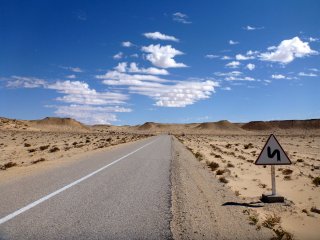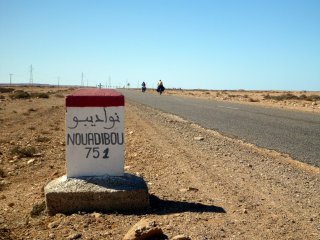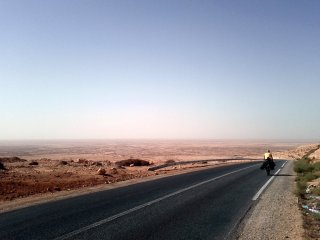After our rest day off the bikes in Dakhla we loaded up again and headed north and then east up the spit to the mainland. The wind seems to never stop in Dakhla and comes out of the northeast so the 40 kilometer ride back to the main road was a tough slog into heavy headwinds. We resorted to riding in a pace line just to get our average speed up to about 10 miles an hour. The view of the dramatic cliffs of the mainland made up for some of the headwind. And as we passed a couple dozen kite surfers at the north end of the bay it was good to see that someone was enjoying the wind.
After an omelette and coffee break at the gas station by the main road junction we turned south. The riding improved as we now had a nice tailwind. We stopped again briefly at the small military town of El Argoub. Upon inquiring about the possibility of staying there for the night we were told that foreigners were not allowed to stay the night there. So we rode on out of town for some kilometers, scoped out a section of coast for a possible campsite, but decided it was too tough to get the bikes down and back. A little further along we found a better campsite behind a low ridgeline of sand, dirt, and crumbling rock walls that provided some shelter from the wind and blocked the view from the road. After exploring a bit I think it was an abandoned military fortification of some sort as it stretched east to west providing good strategic views of the flat, exposed desert to the south.
The area south of Dakhla is remote and sparsely inhabited. We saw perhaps up to 10 vehicles per hour on these stretches of road and had no access to water or food for more than 200 kilometers after El Argoub. The next day’s ride confirmed another cyclist’s report that the town of “Ain Berda” on the Michelin maps does not exist. We crossed the Tropic of Cancer and then rode into some ever-so-slightly hilly terrain so the ride was interesting. Our second night on this stretch was spent in a dry lake bed where we found a little wind shelter behind some dunes covered in vegetation.
The third day brought us to the town of Centre Bir Gandouz which is not shown on the Michelin maps, but is at the intersection where the maps show a track going south to what they call Bir Gandouz. I don’t know if there are two towns called Bir Gandouz or if the map simply shows it in the wrong place, but it seems an odd error. A little after the town we saw a warning sign for a mined area and so we headed on a good distance before looking for another campsite in an area that had visible tire tracks and goat herding trails.
The next day brought us through some very different landscape as we approached the Mauritanian border. The road wound around rocky hillocks of sandstone carved into Swiss cheese formations (presumably by the wind) for miles and we caught glimpses of big sand dunes some ways off to the east. This rock garden continued for most of the afternoon. We planned to try to spend the night in the town of Guerguerat near the border, but when we finally reached it we found that it was not so much a town as a gas station, a couple over-priced hotels, and a border post. Maps give the impression that there is some distance from the town to the border, but this was wrong. After grabbing some food and loading up on water again we decided to go ahead and cross the border and try to find a place to sleep on the other side.
The Moroccan-Mauritanian border is reported to be heavily mined and the 3 to 5 kilometers of no-man’s land between the border posts is unmaintained by either country so the maze of dirt tracks and abandoned cars give an eerie, surreal feeling. The unease was compounded by a couple men in a car who followed us for a little ways, then parked and watched us struggle to push our bikes through the sand before driving around and ahead of us. However, whatever their intentions, they left us alone and it was not hard to figure out how to get to the Mauritanian border post — just follow the most heavily travelled tracks toward the cell phone tower to the south.
The Mauritanian side of the border is basically a smaller version of the Moroccan side. The border formalities were straightforward and we found an auberge offering shared tents in the back for a more reasonable price than the hotels on the Moroccan side. We also changed our Moroccan Dirhams and some Euros into Mauritanian Ougiya. FYI, if you take this route don’t forget to get enough cash in Dakhla or Boujdour before heading to the border as there are no other towns south of Laayoune with banks. I forgot to get cash in Dakhla so had to borrow some from Pieter and Julian to change into Ougiya.











































































